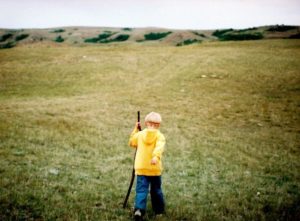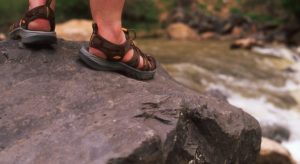I used to do a lot of my hiking alone. People thought I was nuts, and to some degree they were right – after all, traveling in groups is one of the best ways to proactively protect yourself against a bear attack, and having someone around to help out, or even just boost your morale, can be a great help in any emergency. But I needed that time to myself back then. I knew the risks and, after a careful decision each time, I usually chose to accept them.
There were, however, times when I’d start hiking up a favorite trail, get a sudden, sick feeling in my stomach, and turn back right away. If you’re breaking “the rules” by hiking alone, you definitely listen to your gut. Then there were the close bear encounters (alone), and the time a cow moose did her best to trample us. (Thankfully not alone, that time, and the escape involved about an hour of crawling through devil’s club.)
Add all those experiences up, mix them in with a variety of mellowing influences, and I’m a lot happier about hiking in groups nowadays than I used to be. It’s not just about wildlife safety; I appreciate the good company on the trail, and I’ve matured enough that I don’t have to be alone to enjoy the majesty of the wilderness. But having mastered the semi-taboo rules of hiking alone, I had to turn around and learn how to get along with others — others that might end up every bit as dirty, tired, or stressed out by the end of the hike as I am. Here’s what I’ve picked up over the years:
Communicate your expectations clearly. You should all be crystal clear on several points before you hit the trail:
- Where you’re going
- Who’s going with you
- How far and fast you’re going
- Who knows your trip plan?
- Every group member’s comfort level. Are you okay with spreading out along the trail, or do you want to stick together?
- A designated turnaround time. This is when you’ll all turn around, no matter how far you have or haven’t gotten, in order to get back home safely before night falls. (Unless, of course, you want to be out hiking at night.)
If you know you’re one of the weaker members in the group, do be realistic about your abilities during the planning stage of the trip. If all your buddies thought you were on board for a long, fast hike, only to find out that you trek at a snail’s pace, they will be understandably upset. But if they know up front that you won’t be the fastest or have the most stamina, they’re usually willing to make allowances, whether that means slowing the hike or inviting you along for a different outing that’s more your speed.
Speak up before your need is critical. Once you’re in (with full disclosure about your abilities), be prepared to push yourself out of your comfort zone a little bit. But once you feel yourself start to flag, speak up before your need is critical. That way you still have the option of hiking slowly or continuing on to a better stopping spot. If you wait until you’re completely exhausted before you say anything, you’re obligating everyone else to an immediate emergency stop.
Be willing to take one for the team. If you’re one of the stronger hikers in the group and see less-able members starting to flag, step up and suggest that it’s time to slow down or take a break before they hit the point of desperation.
Take care of yourself. Unless you’ve discussed it with other members of your group beforehand and decided otherwise, plan to be completely self-sufficient during your hiking trip. That means carrying your own layers of clothing, dry socks, water, snacks, first aid, and emergency supplies. If it’s cold you want to wear a windbreaker or even a hardshell jacket. That might sound like a lot, but with a little practice, you can get your packing list down to just the essentials.
Not only does this self-sufficiency keep you from being a burden on others, being well-prepared means you’re better able to help out if someone around you needs assistance.
Enjoy the Ride!
You might see new sides of old friends once you hit the hiking trail together – after all, you’re deliberately stepping into an uncontrolled environment, and there’s nothing like dealing with the realities of life in the woods – including unexpected pit stops or getting lost together – to show you a person’s true character. That’s all part of the adventure.













